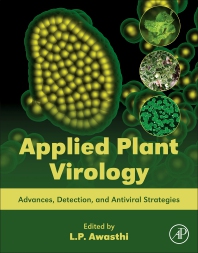Ver ítem
- xmlui.general.dspace_homeCentros e Institutos de InvestigaciónCIAP. Centro de Investigaciones AgropecuariasInstituto de Patología VegetalPartes de librosxmlui.ArtifactBrowser.ItemViewer.trail
- Inicio
- Centros e Institutos de Investigación
- CIAP. Centro de Investigaciones Agropecuarias
- Instituto de Patología Vegetal
- Partes de libros
- Ver ítem
Papaya ringspot virus–Carica papaya pathosystem
Resumen
This chapter explains why papaya ringspot virus (PRSV) is a global threat to Carica papaya L. and discuses some aspects papaya origin, taxonomy, distribution, global production, and genetic and genomic resources. PRSV belongs to the genus Potyvirus, family Potyviridae, and may cause mosaicism, leaf deformation, and concentric rings in fruits. Two PRSV biotypes have been identified, P and W. Hosts include Chenopodium quinoa, Cucumis melo, Cucumis sativus,
[ver mas...]
This chapter explains why papaya ringspot virus (PRSV) is a global threat to Carica papaya L. and discuses some aspects papaya origin, taxonomy, distribution, global production, and genetic and genomic resources. PRSV belongs to the genus Potyvirus, family Potyviridae, and may cause mosaicism, leaf deformation, and concentric rings in fruits. Two PRSV biotypes have been identified, P and W. Hosts include Chenopodium quinoa, Cucumis melo, Cucumis sativus, Cucurbita maxima, Cucurbita moschata, Cucurbita pepo, Diplocyclos palmatus, Momordica charantia, Robinia pseudoacacia, and Clitoria ternatea. PRSV may be transmitted by seeds and by aphids in a nonpersistent manner. Detection methods include indicator plants and serological and molecular methods. PRSV integrated management may be implemented by plantation season, raising border crop, cultivar preference, virus-free seedlings, application of insecticides, regular weeding, and eradication of infected plants. Here, we summarize the main aspects of PRSV, which is the most damaging virus pathogen to papaya worldwide.
[Cerrar]

Autor
Cabrera Mederos, Dariel;
Giolitti, Fabian;
Leiva Mora, Michel;
Portal, Orelvis;
Editor - Compilador
Awasthi, L.P.;
Fuente
Applied Plant Virology : Advances, Detection, and Antiviral Strategies / editor: L.P. Awasthi. Academic Press 2020. p. 461-469
Fecha
2020-05-14
Editorial
Academic Press
ISBN
978-0-12-818654-1
978-0-12-822053-5 (online)
978-0-12-822053-5 (online)
Formato
pdf
Tipo de documento
parte de libro
Palabras Claves
Derechos de acceso
Restringido
 Excepto donde se diga explicitamente, este item se publica bajo la siguiente descripción: Creative Commons Attribution-NonCommercial-ShareAlike 2.5 Unported (CC BY-NC-SA 2.5)
Excepto donde se diga explicitamente, este item se publica bajo la siguiente descripción: Creative Commons Attribution-NonCommercial-ShareAlike 2.5 Unported (CC BY-NC-SA 2.5)
Metadatos
Mostrar el registro completo del ítemÍtems relacionados
Mostrando ítems relacionados por Título, autor o materia.
-
Distribution and phylodynamics of papaya ringspot virus on Carica papaya in Cuba
Cabrera Mederos, Dariel; Giolitti, Fabian; Torres, Carolina; Portal, Orelvis (Wiley; British Society for Plant Pathology, 2018-09)Orchard and garden papaya crops grown in 47 Cuban municipalities were surveyed from 2008 to 2013, revealing the widespread distribution of papaya ringspot virus (PRSV) in Cuba. Phylodynamic analyses performed with the ... -
Aggressiveness of Cuban Papaya ringspot virus Isolates on Carica papaya L. cv. Maradol Roja under Greenhouse Conditions
Cabrera Mederos, Dariel; Cruz, Maylin; Nome Docampo, Claudia; Giolitti, Fabian; Portal, Orelvis (SciTechnol, 2017-04-16)Carica papaya is a major fruit crop in tropical and subtropical regions; however, its production has several constraints. Papaya ringspot virus (PRSV) is the most important pathogen affecting papaya plantations. Symptoms ... -
Caracterización del virus de la mancha anular de la papaya, epifitiología y manejo de la enfermedad en Carica papaya L. en Cuba
Portal Villafaña, Orelvis; Cabrera Mederos, Dariel; Rodríguez Martínez, Douglas (Academia de Ciencias de Cuba, 2019)La prospección de plantaciones de papaya reveló que el virus de la mancha anular de la papaya (PRSV) se encuentra ampliamente distribuido en Cuba, con valores de incidencia y severidad elevados. La diversidad de las ...

